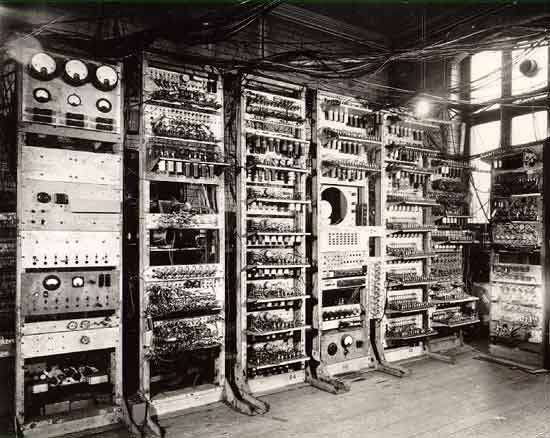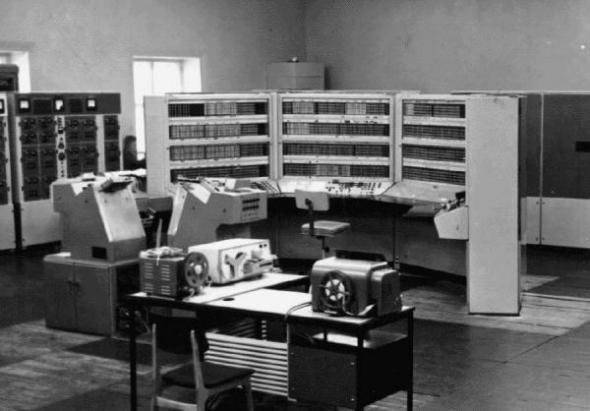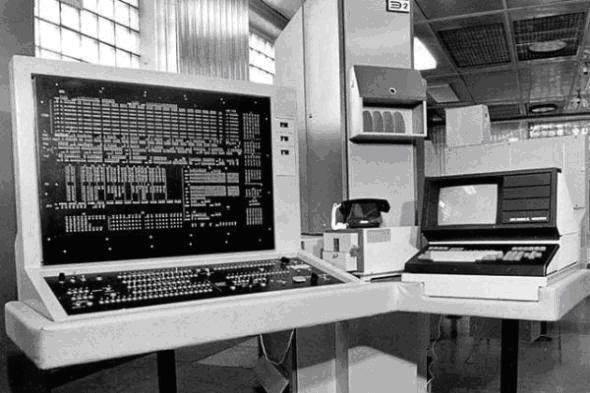Myths of the United States. The backwardness of the Soviet computer technology

“If we consider the models of weapons of different types of troops, and even in the historical aspect, how many samples of Soviet military equipment were the best compared with the same American? Where was the most money, modern research and production equipment, scientists? Maybe the USSR was the leader in the creation of computers, software? "
I want to say a separate thank you sevtrash, which encouraged me to write this article, and whose commentary phrases I used as an epigraph.
The phrases “Russian processor” or “Soviet computer” unfortunately cause a number of specific associations introduced by our media, mindlessly (or, on the contrary, consciously) replicating western articles. Everyone has become accustomed to thinking that these are antediluvian devices, bulky, weak, inconvenient, and indeed, domestic technology is always a reason for sarcasm and irony. Unfortunately, few people know that the USSR at certain moments stories computing was "ahead of the rest." And even less information you will find about modern domestic developments in this area.
The Soviet Union is called a country that possessed one of the strongest scientific schools in the world, not only “leavened” patriots. This is an objective fact, based on an in-depth analysis of the education system by experts of the British Association of Educators. Historically, in the USSR, special emphasis was placed on the training of specialists in the field of natural sciences, engineers and mathematicians. In the middle of the 20th century, there were several schools of computer engineering in the Soviet Union, and there was no shortage of qualified personnel for them, which is why there were all the prerequisites for the successful development of a new industry. Dozens of talented scientists and engineers participated in the creation of various systems of electronic computing machines. We are now talking only about the major milestones in the development of digital computers in the USSR. Work on analog machines was begun even before the war, and in 1945, the first in the USSR analog machine was already working. Before the war, research and development of high-speed triggers, the basic elements of digital computers, began.

Sergey Alekseevich Lebedev (1902 - 1974) is reasonably called the founder of the development of computing technology in the Soviet Union - 15 types of computers were developed under his leadership, from the simplest tube to supercomputers on integrated circuits
In the USSR, it was known about the creation of the ENIAC machine by the Americans in 1946, the first computer in the world with electronic tubes as an element base and automatic program control. Despite the fact that Soviet scientists knew about the existence of this machine, nevertheless, like any other information that had leaked into Russia during the Cold War, these data were very scarce and vague. Therefore, talk about the fact that the Soviet computer technology was copied from Western samples - no more than insinuations. Yes, and what kind of "samples" can we talk about, if the existing models of computers at that time occupied two or three floors and only a very limited circle of people had access to them? The maximum that could have been obtained by domestic spies is fragmentary information from technical documentation and transcripts from scientific conferences.
At the end of 1948, academician S.A.Lebedev began work on the first domestic machine. A year later, the architecture was developed (from scratch, without any borrowing), as well as the schematic diagrams of individual units. In 1950, the computer was mounted in record time by only 12 researchers and 15 technicians. Lebedev called his brainchild “The Small Electronic Calculating Machine”, or MESM. The “baby”, consisting of six thousand electron tubes, occupied the whole wing of a two-story building. Let no one be shocked by such dimensions. Western designs were no less. The fiftieth year was in the courtyard and radio tubes ruled the ball.
It should be noted that in the USSR MESM was launched at a time when there was only one computer in Europe - the British EDSAC, which was launched just a year earlier. But the MESM processor was much more powerful due to the parallelization of the computational process. A similar EDSAK machine - TsEM-1 - was commissioned at the Institute of Atomic Energy in 1953 year - and it also surpassed EDFA by a number of parameters.
When creating the MESM, all the fundamental principles of creating computers were used, such as the presence of input and output devices, the coding and storage of the program in memory, the automatic execution of calculations based on the program stored in the memory, etc. Most importantly, it was a computer based on binary logic used in computer technology (the American ENIAC used the decimal system (!!!), and in addition, the principle of pipelining developed by SA Lebedev was applied to it when command and command flows The operands are processed in parallel, now used in all computers in the world.
Following the small electron-counting machine, a large one followed - the BESM-1. The development was completed in the autumn of 1952, after which Lebedev became a full member of the USSR Academy of Sciences.
The new machine took into account the experience of creating MESM and applied improved element base. The computer had 8-10 speed of thousands of operations per second (versus only 50 operations per second at MESM), external storage devices were made on the basis of magnetic tapes and magnetic drums. Somewhat later, scientists experimented with drives on mercury tubes, potentialoscopes and ferrite cores.
If in the USSR they knew little about Western computers, then in Europe and the USA they knew practically nothing about Soviet computers. Therefore, the report of Lebedev at a scientific conference in Darmstadt became a real sensation: it turned out that the BESM-1 assembled in the Soviet Union is the most productive and powerful computer in Europe.
In 1958, after another upgrade of the BESM RAM, which was already called BESM-2, it was mass-produced at one of the Union’s factories. The further work of the team led by Lebedev was the development and improvement of the first BESM. A new family of supercomputers under the brand “M” was created, whose serial model M-20, which performed up to 20 thousands of operations per second, was at that time the fastest operating computer in the world.
1958 year was another important, albeit little-known milestone in the development of computer technology. Under the leadership of V. S. Burtsev, a student of Lebedev, the complex consisting of several M-40 and M-50 machines (deep modernization of M-20), including those located on a mobile platform, was interconnected into a wireless network that worked on distances to 200 km. At the same time, it is officially considered that the world's first computer network started working only in the 1965 year, when the TX-2 computers of the Massachusetts Institute of Technology and the Q-32 SDC in Santa Monica were connected. Thus, contrary to the American myth, the computer network was first developed and implemented in the USSR, as much as 7 years earlier.
Especially for the needs of the military, including the Space Control Center, several computer models based on M-40 and M-50 were developed, which became the “cybernetic brain” of the Soviet antimissile system created under the guidance of V.G. Kisunko and the real rocket shot down in 1961 year - the Americans were able to repeat it only in 23 year.
The first full-fledged car of the second generation (on a semiconductor basis) was the BESM-6. This machine had a record for that time speed - about a million operations per second. Many of the principles of its architecture and structural organization were a real revolution in computing technology of that period and, in fact, were already a step into the third generation of computers.

BESM-6, created in the USSR in 1966, had a record for that time speed - about a million operations per second
In BESM-6, RAM was split into blocks allowing simultaneous sampling of information, which dramatically increased the speed of accessing the memory system, widely used the principle of combining command execution (up to 14 machine commands could be in the processor at different stages of execution at the same time). This principle, named by the chief designer of BESM-6, academician S.A. Lebedev, the principle of "plumbing", was later widely used to improve the performance of universal computers, receiving in modern terminology the name "command pipeline". A query buffering method was introduced for the first time, a prototype of a modern cache was created, an effective system of multitasking and accessing external devices was implemented, and many other innovations, some of which are still in use. BESM-6 was so successful that it was mass-produced during 20 years and effectively worked in various government structures and institutions.
By the way, the International Center for Nuclear Research created in Switzerland used the BESM machines for calculations. And one more significant fact that beats the myth of the backwardness of our computing technology ... During the Soviet-American Soyuz-Apollon space flight, the Soviet side using the BESM-6 received the processed telemetry information in a minute - half an hour earlier than the American side .
Interesting in this regard is the article by the curator of the Computer Museum in the United Kingdom, Doron Sveid, about how he bought one of the latest BESM-6 in Novosibirsk. The title of the article speaks for itself: "The Russian BESM series of supercomputers, which was developed more than 40 years ago, may testify to the lies of the United States, which declared technological superiority during the Cold War years."

In the USSR, there were many creative teams. The institutes of S.A.Lebedev, I.S.Bruk, V.M.Glushkov are only the largest of them. Sometimes they competed, sometimes complemented each other. And everyone worked on the edge of world science. So far we have been talking mainly about the developments of academician Lebedev, but the rest of the teams were ahead of foreign developments in their work.
For example, at the end of 1948, employees of the Power Engineering Institute. Kruzhizhanovskiy Brooke and Rameev receive a copyright certificate on a computer with a common bus, and in 1950-1951. create it. In this machine, for the first time in the world, instead of electronic tubes, semiconductor (cuprox) diodes are used.
And in the same period when S.A.Lebedev created the BESM-6, academician V.M. Glushkov completed the development of a large computer "Ukraine", the ideas of which were later used in large American computers 1970-s. The MIR computer family created by Academician Glushkov was twenty years ahead of the Americans - these were types of personal computers. In 1967, IBM bought MIR-1 at an exhibition in London: IBM had a dispute over priority with competitors, and the car was bought to prove that the principle of stepwise microprogramming patented by competitors in 1963 was long known Russian and used in serial machines.

The pioneer of computer science and cybernetics, academician Viktor Mikhailovich Glushkov (1923-1982) is known to specialists all over the world for its scientific results of world importance in mathematics, computer science and cybernetics, computing and programming
The next stage in the development of computer technology in the USSR was the work on the creation of a super-computer, the family of which was called Elbrus. This project was started by Lebedev, and after his death he was headed by Burtsev.
The first multiprocessor computing complex Elbrus-1 was launched in 1979 year. It included 10 processors and had a speed of about 15 million operations per second. This car was several years ahead of the leading Western computer models. Symmetric multiprocessor architecture with shared memory, the implementation of protected programming with hardware data types, superscalar processor processing, a single operating system for multiprocessor complexes - all of these features implemented in the Elbrus series, appeared much earlier than in the West, the principle of which is used today day in modern supercomputers.

"Elbrus" in general introduced a number of revolutionary innovations into the theory of computers. These are superscalar (processing more than one instruction per cycle), the implementation of protected programming with hardware data types, pipelining (parallel processing of several instructions), etc. All these possibilities first appeared in Soviet computers. Another major difference between the Elbrus system and others like it, which were previously released in the Soviet Union, is a focus on high-level programming languages. The base language (“AutoCode Elbrus El-76”) was created by V. M. Pentkovsky, and later became the chief architect of Pentium processors.
The next model of this series, "Elbrus-2", has already performed 125 million operations per second. "Elbrus" worked in a number of important systems related to the processing of radar information, they were counted in license plates of Arzamas and Chelyabinsk, and many computers of this model still provide the functioning of anti-missile defense systems and space forces.
The latest model in this series was the Elbrus 3-1, which was distinguished by its modular construction and was designed to solve large scientific and economic problems, including the modeling of physical processes. Its speed reached 500 of millions of operations per second (on some teams), twice as fast as the most productive American supercar of the time, the Cray Y-MP.
After the collapse of the USSR, one of the Elbrus developers, Vladimir Pentkovsky emigrated to the USA and got a job at Intel. Soon he became the lead engineer of the corporation and, under his leadership, Intel developed the Pentium processor in 1993, according to rumors, named after Pentkovsky.
Pentkovsky embodied the Soviet know-how that Intel knew in Intel's processors, and by the year 1995, Intel released a more advanced Pentium Pro processor, which came very close to the Russian 1990 microprocessor of the year El-90, but did not catch up with it , although it was created on 5 years later.
According to Keith Diffendorff, editor of the Microprocessor Report, Intel took over the vast experience and advanced technologies developed in the Soviet Union, including the underlying principles of modern architectures such as SMP (symmetric multiprocessing), superscalar and EPIC (Explicitly Parallel Instruction Code - code with explicit instruction parallelism) architecture. On the basis of these principles, computers were already produced in the Union, while in the United States these technologies only "hovered in the minds of scientists (!!!)".
I want to emphasize that the article referred exclusively to computers serially embodied in hardware and mass-produced. Therefore, knowing the actual history of Soviet computing technology, it is difficult to agree with the opinion of its backwardness. Moreover, it is clearly seen that we have consistently been at the forefront in this industry. That's just about it, unfortunately, we do not hear from TV screens or from other media.
Information